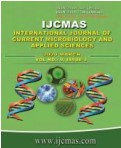


 National Academy of Agricultural Sciences (NAAS)
National Academy of Agricultural Sciences (NAAS)

|
PRINT ISSN : 2319-7692
Online ISSN : 2319-7706 Issues : 12 per year Publisher : Excellent Publishers Email : editorijcmas@gmail.com / submit@ijcmas.com Editor-in-chief: Dr.M.Prakash Index Copernicus ICV 2018: 95.39 NAAS RATING 2020: 5.38 |
The present study was conducted on the wing bones of an adult great Indian horned owl. The humerus was the largest of the wing bones. It had a slightly twisted cylindrical shaft and two expanded extremities. The proximal extremity had a distinct elongated head, a medial tuberosity and a lateral tubercle which continued as the prominent deltoid crest caudolaterally. Distal extremity on its caudal aspect had a wide shallow olecranon fossa. Ulna was thicker and radius was slender rod like. The head of the radius had a facet for radial condyle of humerus and laterally an articular area for ulna. Distal end had a facet for radial carpal. Both radius and ulna enclosed a wide interosseous space. The carpals were two, radial and ulnar carpals. Distal row of carpals were fused with proximal and of metacarpus and formed the carpometa carpus which had three components. The chief component was the 2nd carpometa carpus, 3rd was a thin bony spindle and 1st was a nodule on the proximal end of the chief component. Digits were three, the first digit was the thumb or pollex which had one phalanx. Second digit was the longest with two phalanges. Third digit had one phalanx.
 |
 |
 |
 |
 |